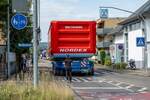11/28/2004
Vestas sees flat 2005 margin, shares drop by 10 %
The world's biggest wind turbine manufacturer repeated its 2004 forecast of an operating profit representing 4 percent of sales after the integration of local peer NEG Micon, but said it saw no margin growth next year, sending its stock to a 16-month low. "The forecast for 2005 is clearly disappointing with a very low margin target and a slightly lower sales forecast than expected," said Sydbank analyst Jakob Pedersen.
For 2005, 12 analysts had on average estimated sales would grow to 3.1 billion euros and saw an operating margin of 6.1 percent, against Vestas' forecast of 4 percent, on sales of 2.6-2.9 billion euros. Exposure to the sliding dollar and rising steel prices had resulted in 2 to 3 percentage points being sliced off its operating margin forecast for 2005, Vestas said in its third-quarter trading statement. But analysts said the disappointing outlook pointed to more fundamental problems with the company's ability to expand in a growing market. "The low margin outlook (for 2005) will lead investors to doubt whether Vestas can create value from the strong growth in the wind turbine market," said Jyske Bank analyst Brian Boersting. At 1530 GMT Vestas was 14 percent down at 67.75 crowns, underperforming the Copenhagen bluechip KFX index, which was 0.5 percent lower.
Vestas said it saw growth in the key US market lagging industry estimates. The company's Chief Executive Svend Sigaard later told a telephone conference he was counting on Vestas being able to maintain its current market share of 35 percent despite increasingly stiff competition from engineering giants Siemens and General Electric. "We can hold our market share at around 35 percent, but it's important to underline that we won't just take orders to keep our market share, we have to earn money on them," he said. Ahead of the announcement, analysts said they had hoped for concrete news of the company's plans to build a plant in North America, which would enable Vestas to reduce its currency exposure. But the company provided no firm news on the matter in its statement. "The extent of the local production set-up and level of investments is yet to be finally determined," said Vestas, adding that further information would be provided in its full-year report, due in late March next year.
The company also said it saw its important German market growing slightly slower than in 2004, but said "positive prospects had materialised" in its other major European markets, Spain and Portugal. Meanwhile, the company's home market is dominated by news of its troubled Horns Reef offshore project, which has required the replacement of about 80 turbines. "The lessons learned from Horns Reef are very expensive," Vestas said, without giving more detailed information on the cost. Analysts have estimated the costs at around 200 million crowns ($35.09 million). Vestas still expects an operating margin of 4 percent this year, including the cost of integrating NEG Micon. Vestas reiterated its guidance for sales of 2.6 billion euros ($3.39 billion) for 2004.
For 2005, 12 analysts had on average estimated sales would grow to 3.1 billion euros and saw an operating margin of 6.1 percent, against Vestas' forecast of 4 percent, on sales of 2.6-2.9 billion euros. Exposure to the sliding dollar and rising steel prices had resulted in 2 to 3 percentage points being sliced off its operating margin forecast for 2005, Vestas said in its third-quarter trading statement. But analysts said the disappointing outlook pointed to more fundamental problems with the company's ability to expand in a growing market. "The low margin outlook (for 2005) will lead investors to doubt whether Vestas can create value from the strong growth in the wind turbine market," said Jyske Bank analyst Brian Boersting. At 1530 GMT Vestas was 14 percent down at 67.75 crowns, underperforming the Copenhagen bluechip KFX index, which was 0.5 percent lower.
Vestas said it saw growth in the key US market lagging industry estimates. The company's Chief Executive Svend Sigaard later told a telephone conference he was counting on Vestas being able to maintain its current market share of 35 percent despite increasingly stiff competition from engineering giants Siemens and General Electric. "We can hold our market share at around 35 percent, but it's important to underline that we won't just take orders to keep our market share, we have to earn money on them," he said. Ahead of the announcement, analysts said they had hoped for concrete news of the company's plans to build a plant in North America, which would enable Vestas to reduce its currency exposure. But the company provided no firm news on the matter in its statement. "The extent of the local production set-up and level of investments is yet to be finally determined," said Vestas, adding that further information would be provided in its full-year report, due in late March next year.
The company also said it saw its important German market growing slightly slower than in 2004, but said "positive prospects had materialised" in its other major European markets, Spain and Portugal. Meanwhile, the company's home market is dominated by news of its troubled Horns Reef offshore project, which has required the replacement of about 80 turbines. "The lessons learned from Horns Reef are very expensive," Vestas said, without giving more detailed information on the cost. Analysts have estimated the costs at around 200 million crowns ($35.09 million). Vestas still expects an operating margin of 4 percent this year, including the cost of integrating NEG Micon. Vestas reiterated its guidance for sales of 2.6 billion euros ($3.39 billion) for 2004.
- Source:
- Online editorial www.windfair.net
- Author:
- Trevor Sievert, Online Editorial Journalist
- Email:
- press@windfair.net
- Keywords:
- Denmark, Vestas, wind energy, wind turbine, wind power, wind farm, offshore, onshore


























